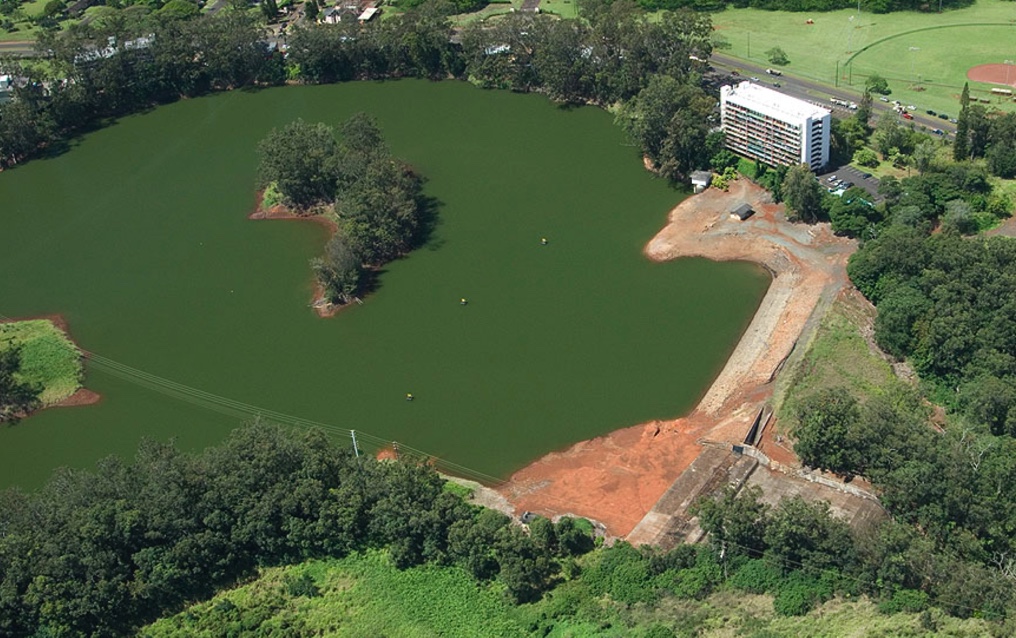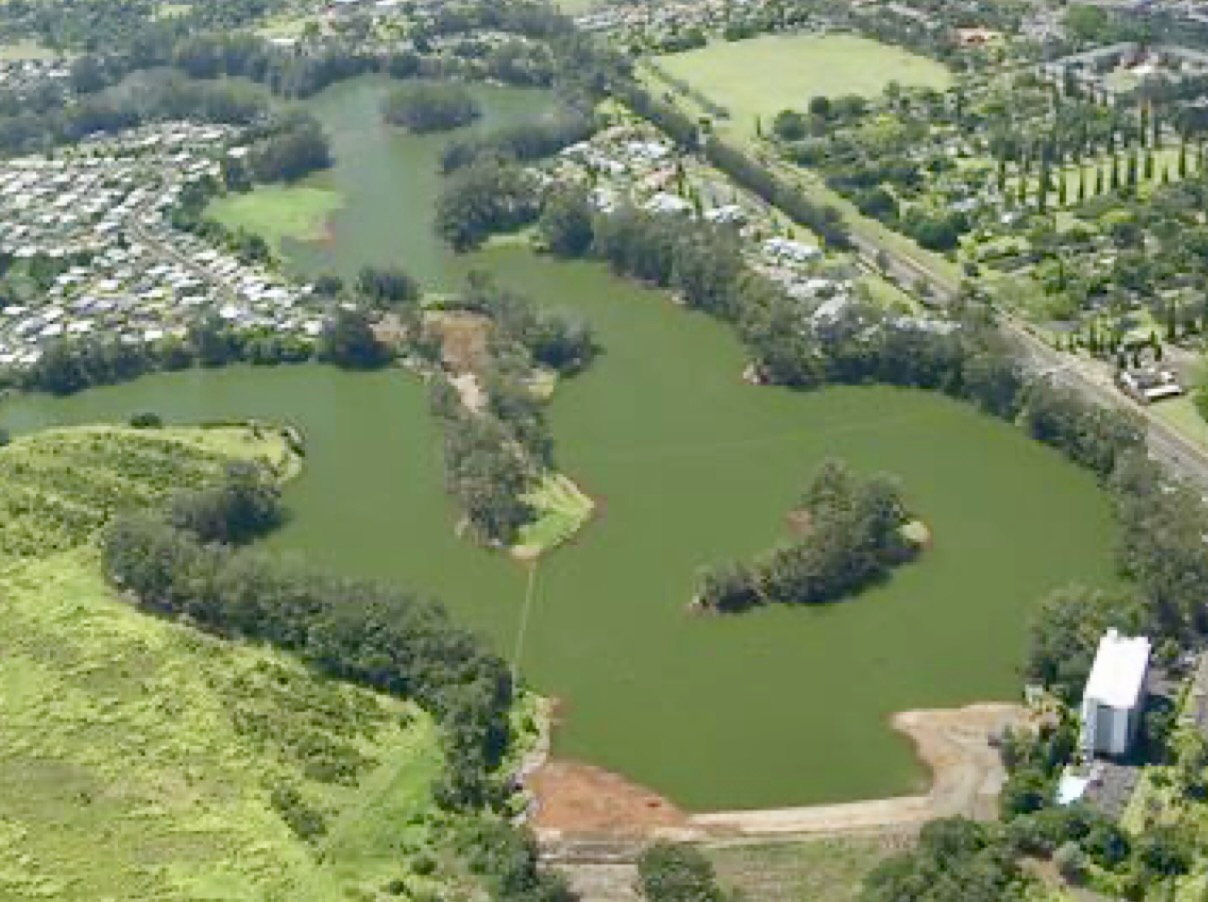“We’re already pushing our luck with a hundred-year-old dam,” said Aimee Barnes last month.
Barnes was the sole member of the state Board of Land and Natural Resources to vote against a recommendation by the Department of Land and Natural Resources’ Engineering Division to give Dole Food Company Hawai‘i more time to meet milestones to make the Wahiawa Reservoir in North O‘ahu safer.
Nearly 15 years ago, the division informed Dole that the deteriorated concrete spillway for the reservoir, which it co-owns with Sustainable Hawai‘i, Inc., was also dangerously small.
Under Hawai‘i administrative rules, high hazard dams such as the Wahiawa Reservoir need to be able to handle a probable maximum flood (PMF). A 2008 report based on an October 2007 inspection found that the reservoir could handle less than half of that.
“Failure to address this deficiency can result in overtopping and failure of the embankment,” wrote Eric Hirano, chief engineer at the time, in a June 2009 letter to Dole Hawai‘i director of operations Dan Nellis.
Wahiawa Reservoir, which sits above the towns of Waialua and Hale‘iwa, can hold just under 3 billion gallons of water. That’s more than six times the capacity of the Kaloko Reservoir on Kaua‘i, the failure of which killed seven people in 2006.
In that June 2009 letter, Hirano tasked Dole with several things, including lowering the water level in the 88-foot-high reservoir to 65 feet, removing unwanted vegetation, and developing plans to increase and improve the spillway.
While Dole made some progress in the years that followed, the undersized spillway remained.
The division issued notices of deficiency in 2016 and again in 2020.
In a December 30, 2020, letter to the DLNR, Nellis reported that in 2018, Dole had received cost estimates for modifying the spillway to pass a PMF storm, and for breaching the dam.
“The high cost of the spillway modification balanced against Dole Hawai‘i’s profit margin is concerning. The 2020 Covid-19 economy has created an even more difficult path forward in pursuing funds as Dole Hawai‘i is operating at a significant loss for 2020, and likely well into 2021,” Nellis wrote, adding that Dole had hired AECOM to perform an “incremental hazard assessment … to potentially support a variance that could reduce the size of a new spillway.”
Because the assessment would not be complete until early 2021, Nellis stated, Dole did not expect to meet the Engineering Division’s March 1, 2021, deadline to submit a dam safety permit application for the construction of a new spillway.
The division may ultimately reject AECOM’s findings. It still hasn’t accepted the conclusions in a 2017 report by R.M. Towill that informed Dole’s spillway cost estimates, and it has asked Dole to explain why the PMF in that report, 32,660 cubic feet per second, is so much less than the 53,437 cf/s PMF estimated in a 2008 U.S. Army Corps of Engineers report.
Fed Up
Given the continuous delays in upgrading the spillway, the Engineering Division finally brought an enforcement action to the Land Board on April 9, 2021.
“In 1921, a 5,000 cfs flood caused the failure of the dam, which was rebuilt with the existing 183-foot-wide spillway. A dam failure of the current dam would flood a significant portion of Waialua and Hale‘iwa towns. … To date, the safety deficiencies with the spillway have not been addressed,” the staff report stated.
The division recommended fining Dole and Sustainable Hawai‘i $20,000 for failing to meet the March 1, 2021, deadline to submit a dam safety permit application. It also recommended that the companies be required to submit within 90 days an explanation for the differences between R.M. Towill’s and the Army Corps’ PMF numbers. The division also recommended giving the company six months to come up with a plan to address the spillway deficiencies and a year to submit a permit application.
Division chief Carty Chang noted that while Dole was keeping the reservoir water level at 65 feet to reduce the risk of overtopping during a storm, he said that a large storm event could fill the reservoir in a matter of hours.
“We count our blessings. However, what has not happened in the past cannot dictate what will happen tomorrow,” he told the board.
Division staff reported that it is working with consultants to recalculate the probable maximum 24-hour rainfall at different areas statewide, which is what PMF estimates are based on.
Because that work won’t be completed for another year or so, the division recommended that the rainfall estimate from a 1963 U.S. Department of Commerce publication, Hydrometeorological Report No. 39 (HMR 39), be used.
That report estimated a probable maximum precipitation (PMP) of 40 inches in 24 hours.
Bill Kappel, president of Applied Weather Associates, which is doing the PMP work for the Engineering Division, said that despite its age, HMR 39 is still a very useful document. “Until our work is completed … it should be the standard,” he said.
Edwin Matsuda, head of the dam safety division, suggested that even though Dole has improved its outlets to drain the reservoir faster, it’s not enough to prevent overtopping if it fills during a big storm.
“Once it’s at that level, they are unable to drain it back down to 65 (feet) for weeks. The whole watershed is slowly draining into the reservoir. … Even when the rain completely stops, they’re probably able to drain at half a foot per day,” Matsuda said.
Nellis testified to the board that Dole has been making good faith efforts to improve the spillway and that one major setback has been that Dole was only recently made aware of potential faults in R.M. Towill’s 2017 PMF study.
“While it appears that we are intentionally dragging our feet, that’s not the case. We did get cost estimates based on studies that R.M. Towill did for us and they were excessive, up to $15 million.”
He said that Dole has been looking for public and private funding, but is also looking to sell the reservoir to investors who want to generate hydroelectric power.
“Dole Hawai‘i will probably go out of business if we have to dig out all this money on our own,” he said, adding that levying fines for non-compliance “is not going to get us to the end zone any faster.”
Matsuda told the board that his division was not trying to be punitive. “We just want to see action taking place,” he said.
Kappel added that while 40 to 45 inches in 24 hours seems like an unbelievable amount of rain, “we’ve seen it happen. Forty-nine inches fell in Kaua‘i in 24 hours. … How much risk do we want to tolerate?”
In the end, the Land Board voted to approve the fine, but extended the division’s proposed deadlines for the PMF justification and spillway plan by three months. It amended the deadline to submit the permit application to be six months after receipt of the dam safety program’s comments on the PMF justification and spillway plan.
More Extensions
On May 13, the Engineering Division returned to the Land Board with a recommendation to extend the deadline to submit the permit application to November 1, 2023. It also recommended several interim deadlines to keep progress on track, as well as pre-approved penalties — ranging from $5,000 to $20,000 — for each missed deadline.
Nellis opposed the automatic penalties and said that fines should only be assessed if the Land Board determined Dole was not working in good faith.
He added that his company was in the process of selling the reservoir to the state. The budget bill passed this year by the Legislature was awaiting the governor’s signature at press time and includes $26 million for the reservoir’s purchase and spillway repair.
Land Board chair and DLNR director Suzanne Case said that because the Wahiawa Reservoir is “high profile, high risk … I just think it’s better to keep the automatic deadlines.”
Board member Barnes noted that the Wahiawa Reservoir project was proceeding without updated guidance on storm risk that accounts for climate change. She asked what kind of insurance Dole held, in case there was any loss of life due to a dam failure.
“I’m not in a position to answer that. The dam may be insured by a third party. I’m not sure,” Nellis replied.
“There is a risk there would be a cost to the state. … The board would potentially be liable or culpable,” Barnes said.
Nellis replied that it was way out of his expertise to comment on that. He said he was very confident the dam is not going to fail, in part because Dole is keeping the water level low. “We’ve handled all of the big storms in the last 120 years,” he said, adding that it has on site an “inflatadam, which gives another cushion.”
Barnes said she was worried about going through another wet season without any progress on the spillway. “The risk of loss of life is concerning,” she said.
The Land Board ultimately approved the recommendations, which included authorizing fines of $5,000 a day for any missed fine payments. Barnes dissented.
Case suggested that the Engineering Division might want to review whether Sustainable Hawai‘i also carries some liability for the spillway’s condition.
Sustainable Hawai‘i owns the spillway, but Dole apparently holds a lease for it.
— Teresa Dawson



Leave a Reply